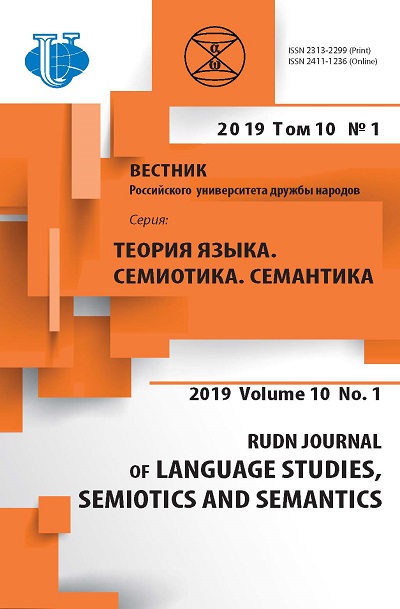THE NUMBER OF PARTICIPANTS AS A COMMUNICATIVE SITUATION FACTOR: A TYPOLOGY OF SITUATIONS WITH THREE PARTICIPANTS
- Authors: Temirgazina Z.K1
-
Affiliations:
- Pavlodar State Pedagogical University
- Issue: Vol 10, No 1 (2019)
- Pages: 108-120
- Section: SPEECH COMMUNICATION IN THE DETERMINANT ANGLE
- URL: https://journals.rudn.ru/semiotics-semantics/article/view/20895
- DOI: https://doi.org/10.22363/2313-2299-2019-10-1-108-120
Cite item
Full Text
Abstract
The topicality of the study of communicative situations with three participants is conditioned by, firstly, the fact that pragma-linguistic characteristics of such form of speech interaction as trilogue should serve as a basis for the program development of chat-robots - virtual interlocutors; secondly, a traditional understanding of a communicative situation without reference to the number of the participants does not fully allow to identify the peculiarities of a person’s speech behavior in small-size speech groups. A communicative situation with three participants possesses a variety of pragmatic characteristic features conditioned by a limited number of verbal communication participants; regularities of turn-taking - the speaker and the listener - among the three participants; the configuration of the participants and the specificity of their relationship; the role-based status of the third person and other circumstances that influence the intentional and semantic aspects of utterances. For the classification of communicative situations two factors are important, particularly, the configuration of the participants and the specificity of their relationship; these features are the ones that determine the other pragmatic characteristics of a communicative situation. Based on these factors three major types of a communicative situation are distinguished: in the first type each of the three communicants are participants of verbal communication taking turns in a conversation, where necessary, with various illocutionary intentions; in the second type one of the communicants is the speaker and two others are addressees; in the third type the first two communicants are primary (the speaker and the addressee) while the third participant is secondary, optional. “The third person” can acquire a definite status in the communicative situation depending on the degree - from minimal to high - of his/her involvement in communication.
About the authors
Zifa K Temirgazina
Pavlodar State Pedagogical University
Author for correspondence.
Email: zifakakbaevna@mail.ru
Dr. of Philological sciences, Professor, Professor of the Russian Language and Literature Department
60, Mira Str., Pavlodar, Republic of Kazakhstan, 140003References
- Neshchimenko, G.P. (2003). Language Situation in Slavic Countries: Description Experience. Concept Analysis. Moscow. (In Russ.).
- Kozhemyakina, V.A., Kolesnik, N.G. & Kryuchkova, T.B. (2006). Dictionary of Sociolinguistic Terms. Moscow. (In Russ.).
- Myskin, S.V. (2015). Typology of Professional Communicative Situations, Bulletin of the Peoples’ Friendship University of Russia: Education Issues: Languages Specialty, 2, 40—55. (In Russ.).
- Vinokur, T.G. (2009). The Speaker and the Listener. Variants of Speech behavior. Moscow: Librokom publ. (In Russ.).
- Chitahova, L.L. (2001). Trilogue as a Form of Communication in Modern French [abstract of dissertation]. Moscow. (In Russ.).
- Zilberman, N.N. (2009). Technologies of Virtual Interlocutors and Forms of Verbal Interaction. Humanitarian Information Science, 5, 80—85. (In Russ.).
- Temirgazina, Z.K. (2009). Modern Theories in Home and Foreign Linguistics. Pavlodar. (In Russ.).
- Davidson, W. (1983). The Third-Person Effect in communication. Public Opinion Quarterly, 47. URL: http://poq.oxfordjournals.org/content/47/1/1 (accessed: 15.09.18).
- Perloff, R.M. (1999). The Third-Person Effect: A Critical Review and Synthesis. Media Psychology, 1, 353—377.
- Clark, G.G. & Carlson, T.B. (1986). Listeners and the Speech Act. In New in Foreign Linguistics. Theory of Speech Acts. Issue 17. Moscow: Progress. pp. 282—285. (In Russ.).













